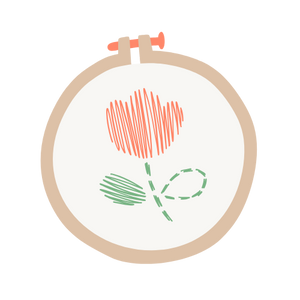Fast & tracked delivery
Your dose of creativity arrives quickly at your home, you can track your package right to your mailbox.


Practicing a manual activity has many benefits for our well-being and personal development. During confinement, hobbies such as sewing, creating original puzzles , discovering sewing kits or making organic cosmetics have experienced a resurgence in popularity. This trend grew with the emergence of the Maker movement in San Francisco, bringing together enthusiasts of crafts and DIY (Do It Yourself). Even figures like Mark Zuckerberg have succumbed to the lure of couture.
These activities are great ways to escape from everyday life, reconnect with yourself and give free rein to your creativity. They encourage disconnection from screens, thus allowing you to find balance and personal satisfaction. By practicing these handmade arts, we can develop new skills, improve our concentration and stimulate our brains in an enriching way. So why not let yourself be seduced by these activities and explore our creative side?
Regularly practicing manual activities can bring many benefits to our body and mind. By creating something concrete with our hands, we enter a mental state called flow, which induces intense relaxation and a deep connection with the present moment.
Ways to control emotions without resorting to medication
Manual activities act as means of control that help regulate emotions, including anger and sadness, without resorting to medication. Art therapy has been shown to be particularly beneficial for people experiencing trauma, such as soldiers suffering from post-traumatic stress. The fact of "doing" during these activities stimulates the senses and makes it possible to give meaning to emotions, thus offering a means of expressing and depositing one's suffering in an artistic creation.
Within medical establishments such as psychiatric hospitals, visual arts workshops play an essential role in patient socialization. Manual activities promote the development of fine motor skills, stimulate creativity and contribute to the enhancement of self-esteem.
The visual arts workshops allowed many participants to regain a feeling of relaxation and to give free rein to their imagination, sometimes evoking memories of childhood and the visual arts classes they took.
The visual artist André Robillard is another inspiring example, having found in artistic creation a way to give meaning to his life and to overcome difficult trials. His work is internationally recognized and his works are present in prestigious collections.
These stories demonstrate the therapeutic power of manual activities and their ability to awaken creativity, strengthen self-confidence and offer a real path to personal development.

In our modern society, we are conditioned to a never-ending quest for productivity, even in our personal lives. The omnipresent screens put additional pressure on our daily lives and can promote depression, especially among young people. The constant stimulation from screens creates a succession of screen time, both at work and during our leisure time, causing an imbalance in our relationship with the real world.
The philosopher and writer Alexandre Lacroix highlights a duality in our use of screens. On the one hand, work-related screen time, with its online meetings, office tasks, and messaging exchanges. On the other side, leisure screen time, dedicated to social networks, watching matches or online shopping. This constant connection to the virtual universe places us as simple actors in a production/consumption system, without realizing that we alternate between production and consumption depending on our use of screens.
Faced with this reality, creative activities such as creating Heishi bead bracelets or starting out in modern embroidery offer a welcome escape. By engaging in these practices, we disconnect from the virtual world and find the time and concentration necessary to create something tangible, concrete. The goal of these activities is not linked to productivity or output, but rather to personal development and the satisfaction of creating a unique object with our own hands.
Crafts require patience, creativity, and allow us to fully immerse ourselves in the present moment. By temporarily leaving the virtual world, we regain the ability to think independently, develop our creativity, and let our minds wander freely. This temporary disconnection offers us a real opportunity to reconnect with ourselves and feel true joy in completing each step of the creative process.
Thus, by practicing them regularly, we rebalance our relationship with technology and find a certain distance from the regime of immediate satisfaction. These moments of escape allow us to rediscover the pleasure of creating and flourishing in the present moment, far from the constraints of the connected world.

Inside our brain, the hypothalamus is the region associated with stress generation. However, there is a calming response that we can stimulate through manual activities such as making jewelry for adults or children. When we engage in a repetitive task like this, the parasympathetic nervous system becomes activated. As a result, the production of cortisol, the stress hormone, decreases. This constitutes a natural chemical process, initiated by manual activities, which has a positive effect on our emotional balance.
Practicing creative activities goes beyond simple relaxation. It stimulates the release of dopamine, a neurotransmitter linked to our internal reward system. This biological mechanism contributes to a feeling of satisfaction and contentment. They appeal to our senses, exploring colors, textures and scents, amplifying this process. Immersing yourself in a creative project thus becomes a natural source of happiness.
When we try a paint kit for adults like Petits Pinceaux paints by number or scratch paint we concentrate on this manual activity, our mind detaches itself from the stressors around us. Focusing on a specific task occupies our minds in a positive way, providing us with respite from anxious thoughts. This type of concentration allows us to experience a state of mental calm, thus creating a soothing break in our day.
Learning new manual skills is a stimulating exercise for our brains. Each new discipline we tackle encourages the development of our brain faculties. At the same time, our ability to concentrate improves, allowing us to explore more creative areas. Psychologists emphasize the importance of developing a strong sense of self-efficacy, which plays a key role in approaching new challenges and resilience in the face of life's disappointments.
By engaging our brain in manual activities, we create emotional balance, promote the production of positive neurotransmitters and strengthen our mental abilities. This enriching process contributes not only to our well-being, but also to our ability to face challenges with confidence and resilience.
Commodo lorem morbi aliquam dui turpis. Iaculis pretium poses nulla tincidunt blandit. A at elementum faucibus integer.

Your dose of creativity arrives quickly at your home, you can track your package right to your mailbox.

Got a problem? Don't panic, you have 15 days to change your mind.

Creative activities for young and old (from 0 to 77 years old!), perfect for disconnecting from screens and spending real time together.

JOY! is fun, colorful, and a touch of madness to dust off your creative leisure activities!
